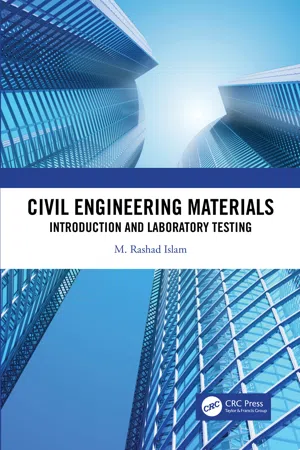
- 478 pages
- English
- ePUB (mobile friendly)
- Available on iOS & Android
About this book
Civil Engineering Materials: Introduction and Laboratory Testing discusses the properties, characterization procedures, and analysis techniques of primary civil engineering materials. It presents the latest design considerations and uses of engineering materials as well as theories for fully understanding them through numerous worked mathematical examples. The book also includes important laboratory tests which are clearly described in a step-by-step manner and further illustrated by high-quality figures. Also, analysis equations and their applications are presented with appropriate examples and relevant practice problems, including Fundamentals of Engineering (FE) styled questions as well those found on the American Concrete Institute (ACI) Concrete Field Testing Technician - Grade I certification exam.
Features:
- Includes numerous worked examples to illustrate the theories presented
- Presents Fundamentals of Engineering (FE) examination sample questions in each chapter
- Reviews the ACI Concrete Field Testing Technician - Grade I certification exam
- Utilizes the latest laboratory testing standards and practices
- Includes additional resources for instructors teaching related courses
This book is intended for students in civil engineering, construction engineering, civil engineering technology, construction management engineering technology, and construction management programs.
Frequently asked questions
- Essential is ideal for learners and professionals who enjoy exploring a wide range of subjects. Access the Essential Library with 800,000+ trusted titles and best-sellers across business, personal growth, and the humanities. Includes unlimited reading time and Standard Read Aloud voice.
- Complete: Perfect for advanced learners and researchers needing full, unrestricted access. Unlock 1.4M+ books across hundreds of subjects, including academic and specialized titles. The Complete Plan also includes advanced features like Premium Read Aloud and Research Assistant.
Please note we cannot support devices running on iOS 13 and Android 7 or earlier. Learn more about using the app.
Information
1 Introduction
1.1 Background

- Aggregates
- Cement
- Cement concrete
- Asphalt binder
- Asphalt concrete
- Steel
- Wood
- Masonry
- Glass
- Composites
1.2 Types of Materials
- a) Metallic
- b) Ceramic
- c) Polymeric
- d) Composite
1.2.1 Metals
- Ferrous metals and alloys, such as irons, carbon steels, alloy steels, stainless steels, etc.
- Nonferrous metals and alloy...
Table of contents
- Cover
- Half-Title
- Title
- Copyright
- Dedication
- Contents
- Preface
- Acknowledgements
- Author
- Chapter 1 Introduction
- Chapter 2 Aggregates
- Chapter 3 Portland Cements
- Chapter 4 Concrete Mix Design
- Chapter 5 Portland Cement Concretes
- Chapter 6 Asphalt Binders
- Chapter 7 Asphalt Mix Design
- Chapter 8 Asphalt Mixtures
- Chapter 9 Steels
- Chapter 10 Woods
- Chapter 11 Masonry
- Chapter 12 Sustainability in Materials
- Laboratory Testing
- Bibliography
- Index